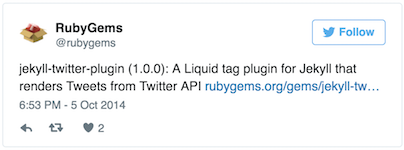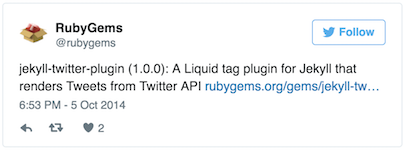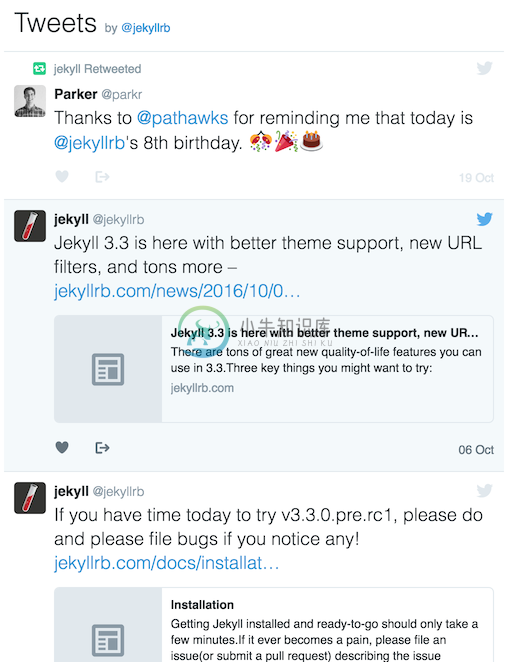jekyll-twitter-plugin
A Liquid tag plugin for the Jekyll blogging engine that embeds Tweets, Timelines and more from Twitter API.
Description
jekyll-twitter-plugin is a Liquid tag plugin for Jekyll that enables Twitter content to be used in any pages generated by Jekyll. Content is fetched from the Twitter Publish platform.
The Publish platform allows Twitter users to curate content for display outside of Twitter. You can display many different types of content with the familiar Twitter styling. We use this API and allow any customisation of the content that is accepted by the Twitter publish platform.
You can now embed any Twitter content in your Jekyll powered blog!
Here are a few examples
Tweet
An example of a Tweet - {% twitter https://twitter.com/rubygems/status/518821243320287232 %}
Timeline
An example of a Timeline - {% twitter https://twitter.com/jekyllrb maxwidth=500 limit=5 %}
Grid Timeline
An example of a Grid Timeline - {% twitter https://twitter.com/TwitterDev/timelines/539487832448843776 limit=5 widget_type=grid maxwidth=500 %}
Moment
An example of a Moment - {% twitter https://twitter.com/i/moments/650667182356082688 maxwidth=500 %}
Features
The plugin supports the following features:
- Installed via Rubygems.
- Customisation - All customisation options passed to Twitter API.
- Authentication - No authentication required!
- Caching - Twitter API responses can be cached to speed up builds.
Getting Started
As mentioned by Jekyll's documentation you have two options; manually import the source file, or require the plugin as a gem.
Require gem
Install the gem, add it to your Gemfile;
gem 'jekyll-twitter-plugin'
Add the jekyll-twitter-plugin to your site _config.yml file for Jekyll to import the plugin as a gem.
plugins: ['jekyll-twitter-plugin']
Manual import
Note: this is deprecated and support will be removed in a later version.
Just download the source file into your _plugins directory, e.g.
# Create the _plugins dir if needed and download project_version_tag plugin
$ mkdir -p _plugins && cd _plugins
$ wget https://raw.githubusercontent.com/rob-murray/jekyll-twitter-plugin/master/lib/jekyll-twitter-plugin.rb
Plugin tag usage
To use the plugin, in your source content use the tag twitter and then pass additional options to the plugin. These are passed to the API.
{% plugin_type twitter_url *options %}
# Example for timeline of the **jekyllrb** user with a maximum of 5 Tweets and with a width of 500px
{% twitter https://twitter.com/jekyllrb maxwidth=500 limit=5 %}
| Argument | Required? | Description |
|---|---|---|
plugin_type |
Yes | Either twitter or twitternocache (same as twitter but does not cache api responses) |
twitter_url |
Yes | The Twitter URL to use, check below for supported URLs. |
*options |
No | Parameters for the API separated by spaces. Refer below and to respective Twitter API documentation for available parameters. |
Custom variables
In addition to passing the Twitter URL directly to the plugin, you can also use Front Matter to store URLs as page variables. This allows you to re-use view configuration or partials by keeping the Twitter URL(s) separate to page content.
---
title: My page
tweets:
- https://twitter.com/dhh/status/1162426045405921282
- https://twitter.com/rails/status/1205565185739673600
a_tweet: https://twitter.com/rubygems/status/518821243320287232
---
{% for tweet in page.tweets %}
{% twitter tweet align=right width=350 %}
{% endfor %}
{% twitter page.a_tweet %}
Supported Twitter URLs
The Twitter URLs that are supported depend on Twitter. We pass the url and all parameters to the API - check Twitter Publish platform for availability. Here is documentation for some common types:
Tweet:
- https://developer.twitter.com/en/docs/twitter-for-websites/overview
- https://developer.twitter.com/en/docs/tweets/post-and-engage/api-reference/get-statuses-oembed
- https://developer.twitter.com/en/docs/twitter-for-websites/embedded-tweets/guides/embedded-tweet-parameter-reference
Timeline:
- https://developer.twitter.com/en/docs/twitter-for-websites/timelines/overview
- https://developer.twitter.com/en/docs/twitter-for-websites/timelines/guides/oembed-api
- https://developer.twitter.com/en/docs/twitter-for-websites/timelines/guides/parameter-reference
Moments:
- https://developer.twitter.com/en/docs/twitter-for-websites/moments/overview
- https://developer.twitter.com/en/docs/twitter-for-websites/moments/guides/oembed-api
- https://developer.twitter.com/en/docs/twitter-for-websites/moments/guides/parameter-reference0
Customisation
All pairs of options and values after the URL are passed to the API. The parameters must be in pairs with the option as the key: option=value.
For example, if you want to limit the width of the embedded content then the API supports a maxwidth option so you could construct the tag as below to limit it to a value of 500 (pixels).
{% twitter https://twitter.com/jekyllrb maxwidth=500 %}
Authentication
The API does not require any authentication.
Previous version of this library used an API that required API keys (TWITTER_CONSUMER_KEY TWITTER_CONSUMER_SECRET TWITTER_ACCESS_TOKEN TWITTER_ACCESS_TOKEN_SECRET). We now print a warning if these are detected as a reminder that you can safely remove them.
Output
All content will be rendered inside a div with the class jekyll-twitter-plugin.
<div class='jekyll-twitter-plugin'>
-- content from API --
</div>
If something goes wrong, then a basic error message will be displayed:
Tweet could not be processed
If we receive an error from the API then a message will be cached and rendered something like this below. If it's a 404, then this suggests the Tweet is protected or deleted. I will not be fetched again and again. If the Tweet is restored, then simply delete the cached response from .tweet-cache directory and build again.
<div class='jekyll-twitter-plugin'>
<p>There was a '{error name}' error fetching Tweet '{Tweet status url}'</p>
</div>
Caching
Twitter API responses can be cached to speed up Jekyll site builds. The reponses will be cached in a directory within your Jekyll project called .tweet-cache. This should not be committed to source control.
Caching is enabled by using the twitter tag.
It is possible to disable caching by using the specific twitternocache tag.
{% twitternocache twitter_url *options %}
# Example
{% twitternocache https://twitter.com/rubygems/status/518821243320287232 %}
Contributions
I've tried hard to keep all code in the one lib/jekyll-twitter-plugin.rb file so that people can just grab this file and include in their Jekyll _plugins directory if they do not want to install with Rubygems. This will be dropped in a later version.
Please use the GitHub pull-request mechanism to submit contributions.
There is a quick integration test in spec/integration_tests.rb that will use the jekyll-twitter-plugin public api and output a file output_test.html. Run this with the following command:
$ ruby spec/integration_tests.rb && open output_test.html
Versioning
We use SemVer for versioning. For the versions available, see the tags on this repository.
License
This project is licensed under the MIT License - see the LICENSE file for details
-
主要记录使用jekyll搭建博客时的一些配置和修改。 注意: >使用时请删除{和%以及{和{之间的空格。 预览文章 source ~/.bash_profile jekyll server 添加about me 边栏 参考the5fire的技术博客在index.html页面加入如下代码: <section> <h4>About me</h4> <div> 一个Java方案架构师,主要从事had
-
Twitter for PHP Twitter API for Laravel 6.x, 7.x, 8.x (and new versions as they are released). Also supports other frameworks viaPHP-DI (or feel free to add support for your framework via PR) You need
-
Jekyll 是一个简单的免费的Blog生成工具,类似WordPress。但是和WordPress又有很大的不同,原因是jekyll只是一个生成静态网页的工具,不需要数据库支持。但是可以配合第三方服务,例如discuz。最关键的是jekyll可以免费部署在Github上,而且可以绑定自己的域名。 快速安装指令: gem install jekylljekyll new my-awesome-sit
-
在本章中,我们将解释如何使用Twitter身份验证。 第1步 - 创建Twitter应用程序 您可以在此link上创建Twitter应用程序。 创建应用程序后,单击“ Keys and Access Tokens ,您可以在其中找到API Key和API Secret 。 您将在第2步中使用此功能。 第2步 - 启用Twitter身份验证 在Firebase信息中心的侧边菜单中,您需要点击Auth
-
我正在尝试对此终结点发出POST请求:https://api.twitter.com/oauth/request_token(作为实现Twitter登录的第一步) 正如文档中所说:https://dev.twitter.com/oauth/reference/post/oauth/request_token不需要身份验证。但是,当我尝试它时,我会得到以下响应: 显然我做错了什么。我有一个注册的应用
-
Twitter将Storm正式开源了,这是一个分布式的、容错的实时计算系统,它被托管在GitHub上,遵循 Eclipse Public License 1.0。Storm是由BackType开发的实时处理系统,BackType现在已在Twitter麾下。GitHub上的最新版本是Storm 0.5.2,基本是用Clojure写的。 Storm为分布式实时计算提供了一组通用原语,可被用于“流处理”
-
Twitter Clone (Click to try �� ) Bulit PHP Twitter Clone IN OOP style and using MYSQL Database. AJAX and Jquery for requests without reloading like Follow/unfollow, like, Search users, Show popups lik






